Intel Core i7-11700K Review: Blasting Off with Rocket Lake
by Dr. Ian Cutress on March 5, 2021 4:30 PM EST- Posted in
- CPUs
- Intel
- 14nm
- Xe-LP
- Rocket Lake
- Cypress Cove
- i7-11700K
Gaming Tests: Borderlands 3
As a big Borderlands fan, having to sit and wait six months for the EPIC Store exclusive to expire before we saw it on Steam felt like a long time to wait. The fourth title of the franchise, if you exclude the TellTale style-games, BL3 expands the universe beyond Pandora and its orbit, with the set of heroes (plus those from previous games) now cruising the galaxy looking for vaults and the treasures within. Popular Characters like Tiny Tina, Claptrap, Lilith, Dr. Zed, Zer0, Tannis, and others all make appearances as the game continues its cel-shaded design but with the graphical fidelity turned up. Borderlands 1 gave me my first ever taste of proper in-game second order PhysX, and it’s a high standard that continues to this day.
BL3 works best with online access, so it is filed under our online games section. BL3 is also one of our biggest downloads, requiring 100+ GB. As BL3 supports resolution scaling, we are using the following settings:
- 360p Very Low, 1440p Very Low, 4K Very Low, 1080p Badass
BL3 has its own in-game benchmark, which recreates a set of on-rails scenes with a variety of activity going on in each, such as shootouts, explosions, and wildlife. The benchmark outputs its own results files, including frame times, which can be parsed for our averages/percentile data.
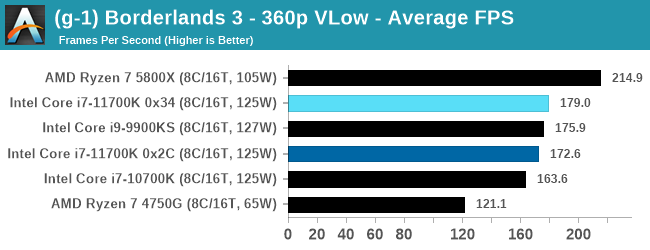
| AnandTech | Low Resolution Low Quality |
Medium Resolution Low Quality |
High Resolution Low Quality |
Medium Resolution Max Quality |
| Average FPS |  |
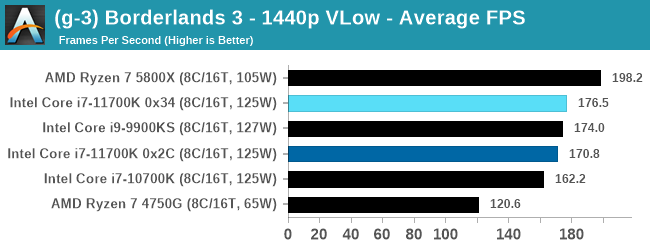 |
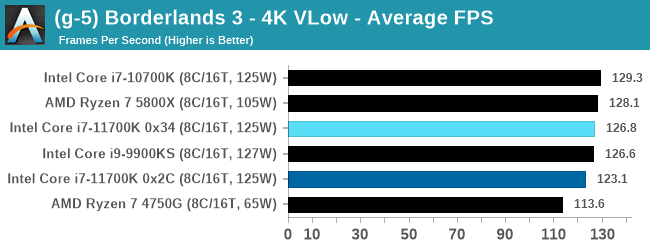 |
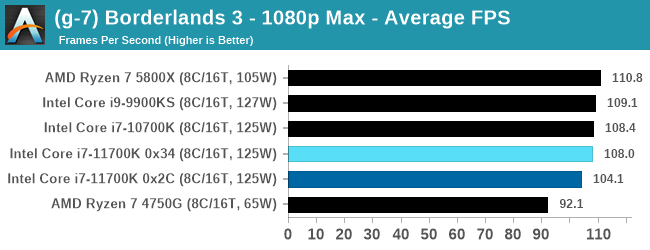 |
| 95th Percentile | 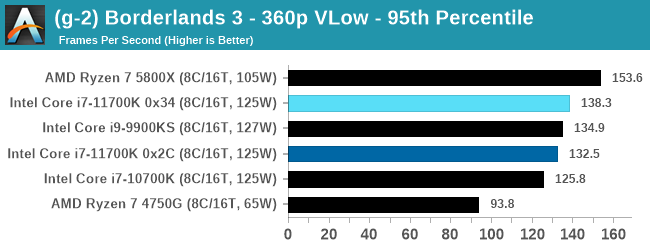 |
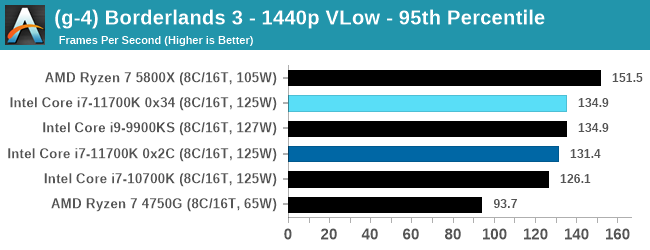 |
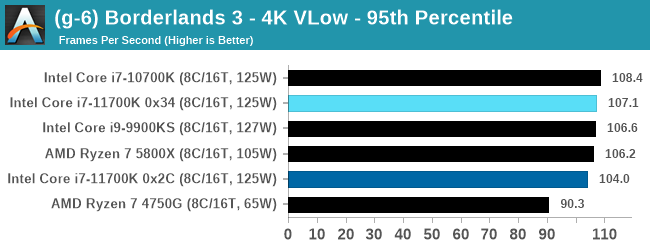 |
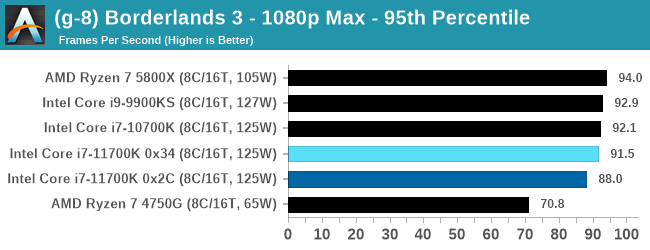 |
With the 9900K sitting at 5.0 GHz, the fact that the 11700K only does single core 5.0 GHz shouldn't matter if the IPC gains on the core help push the needle. Unfortunately, it doesn't seem to do much in Borderlands.
All of our benchmark results can also be found in our benchmark engine, Bench.











541 Comments
View All Comments
Geef - Tuesday, March 9, 2021 - link
What, you don't?Hifihedgehog - Saturday, March 6, 2021 - link
I predicted ~300W peak power about a year or so ago when I first heard they were making the big mistake of bringing AVX-512 to mainstream consumer processors. Why on earth? There was a valid, wise, very, very, very good reason Intel had reserved AVX-512 to just their 14-nm HEDT processors and that had always been the furnace-like heat and nuclear-like power consumption of it. Even with the best logical design improvements from a new microarchitecture, it is still an extremely intensive logical pill of a task to swallow. Now, we see that reason in full, unadulterated display. You bring a massively complex instruction set extension to a higher process node where you have far lengthier physical networks (meaning essentially longer wires, increased resistance, higher power, and maximum heat) and, of course, you are going to have a steaming pile. Remember this review is only looking at the number two product, the Core i7-11700K which has lower clocks and lower power draw. The Core i9-11900K will likely need a 360- or 420-mm AIO just to not thermal throttle like mad. My 5950X with its meager 240mm AIO (Corsair H100i RGB Platinum) that runs at the quiet mode setting is laughing its butt off right about now. When Ian Cutress had to use an obnoxiously loud 170 CFM fan (I have used 100 CFM Deltas and those already annoy most PC enthusiasts) on a massive 4-pound, full copper heatsink to tame the 11700K's 290W, I shudder to think. Will the 11900K be outdoing the FX-9590's record-making peak power draw of 350W (see here: https://www.anandtech.com/show/8316/amds-5-ghz-tur... ? Ian easily could have gotten the 11900K also at retail, but I think he is holding back on that because he already knows the 11900K is going to be a throttling disaster and only the 11700K is an ACTUALLY USABLE PROCESSOR. *mike drop*Hifihedgehog - Saturday, March 6, 2021 - link
I am referring to 14nm mainstream consumer processors if that wasn't abundantly clear.Santoval - Saturday, March 6, 2021 - link
"To be clear, I was replying to you to get a reply at the top of the comments".You got me.. :)
Samus - Saturday, March 6, 2021 - link
In all fairness, it's actually amazing what Intel has achieved here with, essentially, a 6 year old manufacturing process!Spunjji - Monday, March 8, 2021 - link
Are we reading the same review? It looks like they *regressed* in performance vs their 5.5-year-old architecture on the same process.dihartnell - Thursday, March 11, 2021 - link
I think they did they realistically could given the contraints they have. We are not going to see intels true potential until they get thier manufacturing process fixed or they swallow the dead rat and go to another foundry. This will be enough to keep them in the game for another year.Hifihedgehog - Friday, March 5, 2021 - link
Summary image:https://i.redd.it/4i2eu882qbl61.png
tl;dr: Worse in games, moderately better in synthetics, slower and far more power hungry than Ryzen 5000
Bik - Saturday, March 6, 2021 - link
ThanksGondalf - Saturday, March 6, 2021 - link
Main defect of the article: AMD best of the best (low availability) versus a common high volume medium level Intel SKU.No matter the price that will change on retails or OEMS.
I don't understand AMD, they pump hard the pedal still they can not do much to gain market share. New processes are medium volume and with too much customers.
The NEW AMD will be a company capable to deliver a pile of good dies to all channels, without limitation on volume. Unfortunately Lisa follow the wrong street, in this manner Intel will always dominate the market.
Bet 2021 will be Lisa last year at AMD.